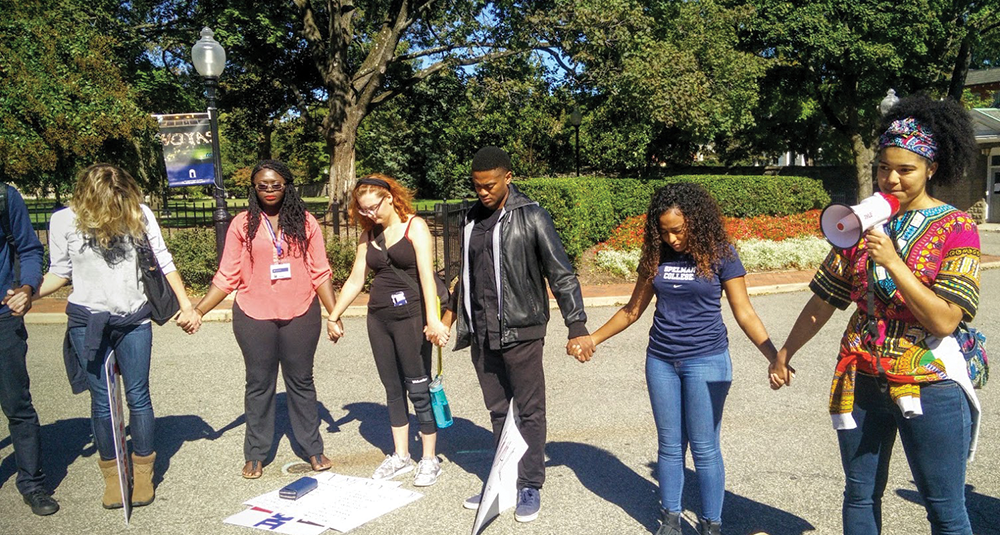
Georgetown students gathered at the university’s front gates before marching to the White House to address the unarmed black victims of police aggression in America.
About 35 Georgetown undergraduate and graduate students marched from the university’s front gates to the White House on Oct. 10 to raise awareness for unarmed black victims of police brutality in America.
Organized by graduate students Raquel King (GRD ’16) and Skylar Cruz (GRD ’18), the rally — titled “Black Bodies are Beings” — sought to specifically address the deaths of Trayvon Martin in 2012, Eric Garner in 2014, Sandra Bland in 2015 and most recently Terrence Sterling, shot by a police officer Sept. 11 in Washington, D.C.
As students, who were notified about the march through a Facebook event page Sept. 30, gathered at the front gates, King began by addressing the killing of unarmed black Americans and her view of today’s youth’s desire for change. The group then gathered for a prayer of solidarity, asking for a successful march and changes to the American policing system.
“We’re backing civil rights,” King said to the protestors at the beginning of the march. “I don’t understand how we’re still going through this when our grandparents talk to us and tell us to be careful. It shouldn’t be like that. We shouldn’t be going through this.”
As King filed a parade permit Oct. 4 for 125 people, the group received a Metropolitan Police Department escort, which included the accompaniment of three motorcycles and five cars for certain stretches of the march and fewer vehicles for other stretches, depending on the location. Police blocked car lanes so the students could peacefully march on O and M streets and Wisconsin and Pennsylvania avenues, which caused up to 10-minute traffic delays in Northwestern D.C.
Although only a third of the expected number of protestors who indicated on Facebook that they would be attending showed up, Raymond Nelson (GRD ’17), president of the graduate student multicultural organization Hoya Circles, said he felt the demonstration helped foster dialogue about police brutality in the Georgetown community.
“If I could do it over again, I would encourage more people to participate. I think part of the turnout had to do with advertising,” Nelson said. “But it was a therapeutic moment to let the frustration out and being able to channel that emotion in a way that was productive felt affirming.”
As the protestors marched, they carried signs listing the names of men and women killed by police and chanted calls reinforcing themes of racial equality and political reform, such as, “It is our duty to fight for our freedom. It is our duty to win” and “What do we want? Change. When do want it? Now.”
Once they reached the White House, the protesters continued their calls for racial reform with nearly an hour of chanting before pausing for a prayer circle.
King said she organized the march after hearing about the death of Terence Crutcher, a 40-year-old black man fatally shot Sept. 16 by officer Betty Shelby in Tulsa, Okla. Shelby was charged with first-degree manslaughter Sept. 23 and released the same day on a $50,000 bond.
“After the Crutcher killing, I messaged my friend at Georgetown Law saying ‘I have to do something. I can’t just sit still and not do something,’” King said in an interview with The Hoya.
However, King said the organizers aimed to highlight the pattern of police killings beyond the Crutcher shooting.
“More than anything I want people to see that we care,” King said. “We are going to be proactive. We are young professionals and will make decisions in our own careers that will change in America.”
Though the march was not affiliated with the Black Lives Matter movement, participants referenced the movement and included its emblem of a raised fist in their promotion of the march.
Tom Chidiac (GRD ’18) said he attended the rally to learn more about issues facing the black community and demonstrate his support for racial equality.
“It’s important to me to be supportive of this movement and do so with my feet, not just Facebook comments,” Chidiac said. “I’m also hoping to learn more about what the organizers find most problematic and how I, as an ally, can be most helpful.”
Carlsky Belizaire (GRD ’18), who helped lead the rally, said he was happy with the results but wished for a bigger turnout and more interactions with pedestrians.
“I’m happy and excited that Georgetown students came out,” Belizaire said. “In the future, hopefully, more people come. I wish I could have reached out to more people. Some people were watching us and there was probably a delay between watching the protests and understanding what we were saying and what was really going on.”




















